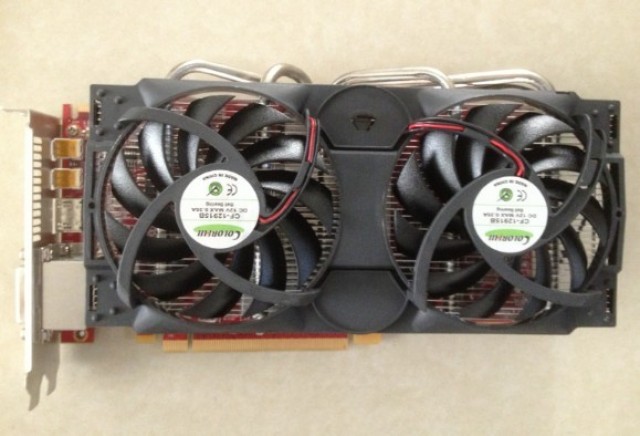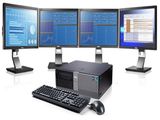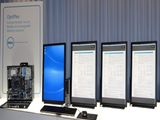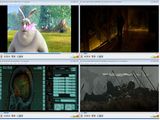6870DHG5
|
| Specification | |
| GPU | AMD Radeon™ HD6870 |
| GPU Core Clock | 900Mhz core clock |
| Video Memory | 1GB GDDR5 |
| Memory Clock / Bandwidth | 1050Mhz GDDR5 (256-bit/4.0Gbps) |
| APIs supported | OpenGL 4.1 OpenCL 1.1 DirectX 11.1 |
| BUS | PCI Express 2.1 x16 bus interface |
| Board Size | ATX form factor |
| Cooler Ventilation | Dual FAN sink Cooler with heat pipes (dual slot) |
| Display Output | 2 x DVIs + 2 x Mini Display Port + HDMI Port |
| Maximum Resolution | 1 x Dual Link DVIs - 2560 x 1600 resolution 1 x Single Link DVIs - 1920 x 1080 resolution 1 x VGA ports - 2048 x 1536 resolution (Required Dongle) Display Port - 2560 x 1600 resolution |
| Power Consumption (loaded) | 151 watts |
| Accessory | CD Driver, Quick Installation Manual, 1 x DVI to VGA dongle |
| O/S support | Windows Vista/7, Windows XP. Ubunta Linux |
| Remark | Direct2Display3x EyeFinity |
All images are for reference only, and are subject to change without prior notice.
All brand names and trademarks are the property of their respective owners.
Established as an OEM/ODM design center and service by a group of experienced engineers of over 15 years in the graphics solution for the IPC business, GXore Inc. Group has integrated the resources and competencies of Hong Kong, Taiwan and China. With its logistic subsidiary in Hong Kong, GXore Inc. group is empowered with a flexible global logistics. Leveraging the sales & finance strength of Taiwan, it has also established R&D Design House; Partner's manufacturing facilities (ROHS), QA center & After-sale RMA service center in China. Since its inception, GXore Inc. group has been specializing in IPC graphics design and manufacturing, providing the ODM as well as the customized OEM services to US, Europe, Japan and Korea. GXore Inc. group’s goal is to fully satisfy every demand of every customer by the highest standard of product quality in the most efficient way.
Application
| Commercial Sector Design for enabling multi-screen display walls designed to attract, inform and engage audiences or foster collaborative interaction and decision making. Such configurations include: • Advertising & Point-of-Sale (e.g. digital billboards, posters and digital menus) • Command & Control, Operations or Process Control Centers (e.g. utilities, emergency services, security) • Conferences & Presentations (e.g. auditoriums, convention centers, conference rooms) • Entertainment/Infotainment & Events (e.g. sports arenas, movie theaters, concerts) • Informational Displays • Simulation & Training (e.g. flight, automobile or ship’s bridge simulators) • Video Conferencing • HD 3D Gaming and Entertainment Powerful, flexible and affordable multi-display graphics product the display wall market besides gaming entertainment, has been waiting for–offering the lowest TCO for powering display walls comprised of 3 x screens, high display density and long-lasting, high quality multimedia performance. |
 | World of BitCoins MinersCost effective 6850 design supports for the Bitcoins mining applications. Why are AMD GPUs faster than Nvidia GPUs? AMD designs GPUs with many simple ALUs/shaders (VLIW design) that run at a relatively low frequency clock (typically 1120-3200 ALUs at 625-900 MHz), whereas Nvidia's microarchitecture consists of fewer more complex ALUs and tries to compensate with a higher shader clock (typically 448-1024 ALUs at 1150-1544 MHz). Because of this VLIW vs. non-VLIW difference, Nvidia uses up more square millimeters of die space per ALU, hence can pack fewer of them per chip, and they hit the frequency wall sooner than AMD which prevents them from increasing the clock high enough to match or surpass AMD's performance. This translates to a raw ALU performance advantage for AMD:
This approximate 2x-3x performance difference exists across the entire range of AMD and Nvidia GPUs. It is very visible in all ALU-bound GPGPU workloads such as Bitcoin, password bruteforcers, etc. Secondly, another difference favoring Bitcoin mining on AMD GPUs instead of Nvidia's is that the mining algorithm is based on SHA-256, which makes heavy use of the 32-bit integer right rotate operation. This operation can be implemented as a single hardware instruction on AMD GPUs (BIT_ALIGN_INT), but requires three separate hardware instructions to be emulated on Nvidia GPUs (2 shifts + 1 add). This alone gives AMD another 1.7x performance advantage (~1900 instructions instead of ~3250 to execute the SHA-256 compression function). Combined together, these 2 factors make AMD GPUs overall 3x-5x faster when mining Bitcoins. Above is example of usage reference in mining Bitcoins. |
| Support Multi-monitor Management Software enables you to tailor your display formation to the way you work and playback video contents, so you can manage increased amounts of information, video contents and improve your productivity.
Flexible and easy to use : Managing independent monitor display features for work and commercial sector :
Increase your work productivity for multi-Monitors display :
|
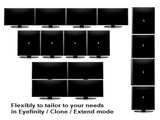 | See more. Do more. Flexibly to tailor to your needs ! AMD Eyefinity technology enables you to run up to four independent and simultaneous displays with a single graphics card. By expanding your field of view across multiple high-resolution monitors, you can see more detail than ever, helping to increase your workflow productivity. You can manage multitasking more efficiently, and view more data, applications, and images at once. |






